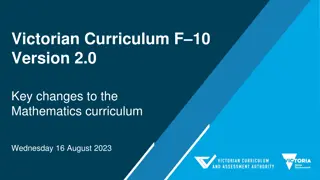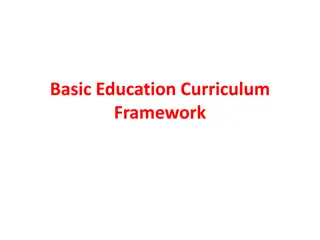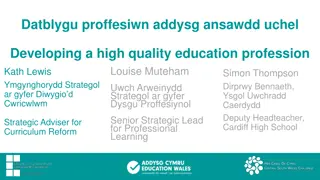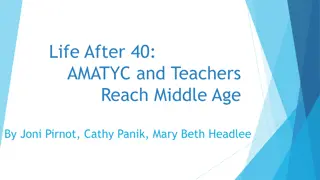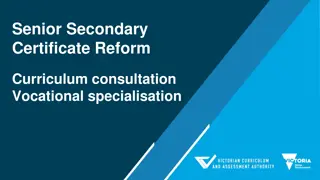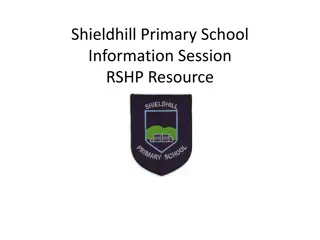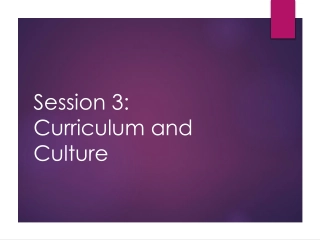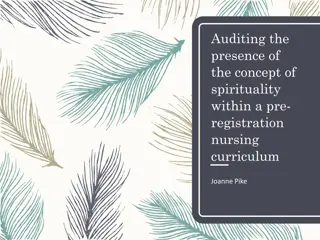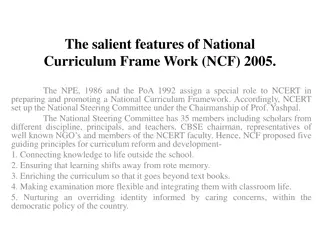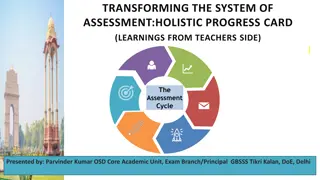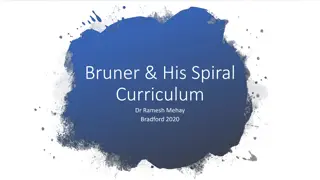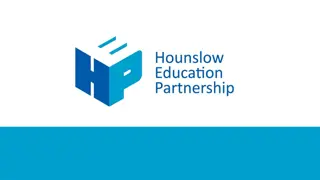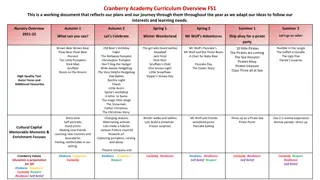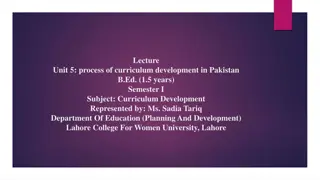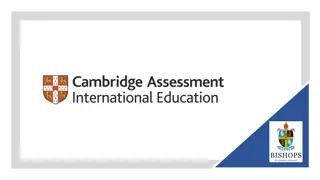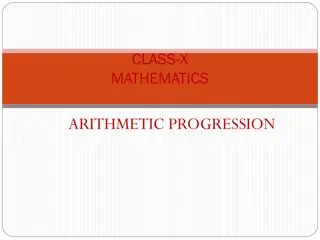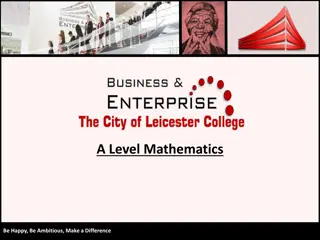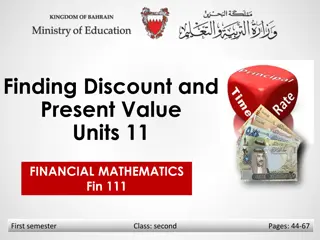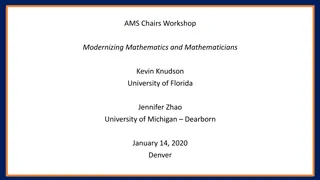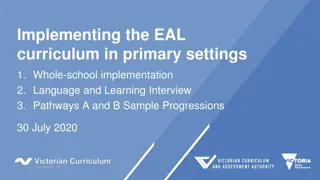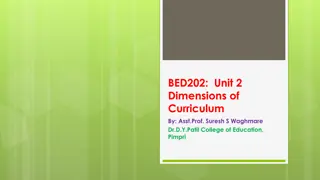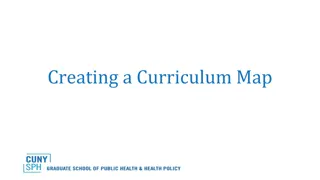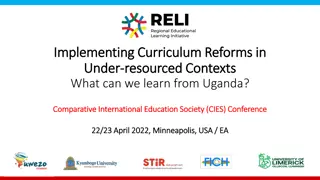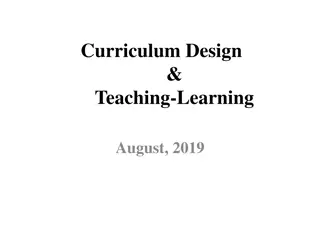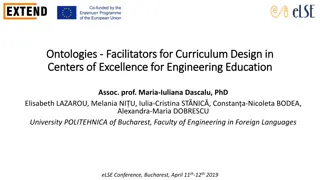Enhancing Mathematics Learning: ACARA Curriculum Session Insights
Learning mathematics and numeracy involves students making connections between ideas, aiming to develop expert mathematicians and users in various professions. The curriculum focuses on clarity and depth rather than rushing through topics, emphasizing understanding, fluency, problem-solving, and reasoning. The proficiencies are integral components of the Australian curriculum, not additional elements. Visual aids and comparisons like Easter egg hunting and learning to ride a bike are used to highlight different aspects of learning mathematics.
Download Presentation

Please find below an Image/Link to download the presentation.
The content on the website is provided AS IS for your information and personal use only. It may not be sold, licensed, or shared on other websites without obtaining consent from the author. Download presentation by click this link. If you encounter any issues during the download, it is possible that the publisher has removed the file from their server.
E N D
Presentation Transcript
Abstract Learning mathematics and numeracy involves students making connections between ideas for themselves. ACARA session 1
Overall goals of the curriculum development of expert mathematicians expert users of mathematics in the professions a workforce capable of meeting all numeracy requirements citizens able to use the mathematics they need ACARA session 1
the curriculum is intended to be clear and succinct, and this is about pedagogy clarity is needed for interactivity not about setting low expectations for teachers demands for additional detail should be resisted Often teachers feel they have to rush from one topic to the next, and this is bad for teaching studying combined topics in more depth some topics are more important than others ACARA session 1
Easter ACARA session 1
Teaching kids to ride ACARA session 1
Some aspects of learning mathematics are like hunting for Easter eggs, some aspects are like learning to ride a bike, and some are like learning French ACARA session 1
In the Australian curriculum Understanding (connecting, representing, identifying, describing, interpreting, sorting, ) Fluency (calculating, recognising, choosing, recalling, manipulating, ) Problem solving (applying, designing, planning, checking, imagining, ) Reasoning (explaining, justifying, comparing and contrasting, inferring, deducing, proving, ) ACARA session 1
The proficiencies are core components (not add ons) ACARA session 1
The proficiencies are core components (not add ons) ACARA session 1
There is agreement that tasks are important in the mathematics classroom, it is through tasks, more than in any other way, that opportunities to learn are made available to the students (Anthony & Walshaw, 2009, p.96). ACARA session 1
And those tasks should be challenging Christiansen and Walther (1986) argued that non-routine tasks, because of the interplay between different aspects of learning, provide optimal conditions for cognitive development in which new knowledge is constructed relationally and items of earlier knowledge are recognised and evaluated. ACARA session 1
Especially if we wish to go beyond developing fluency Kilpatrick et al. (2001) teachers who seek to engage students in developing adaptive reasoning and strategic competence (or problem solving) should provide them with tasks that are designed to foster those actions. ACARA session 1
and the tasks can address the goals of the curriculum National Council of Teachers of Mathematics (NCTM) (2014) noted: Student learning is greatest in classrooms where the tasks consistently encourage high-level student thinking and reasoning and least in classrooms where the tasks are routinely procedural in nature. (p. 17) ACARA session 1
Cognitive activation tasks require students (prior to instruction) to plan their approach, especially sequencing more than one step; process multiple pieces of information, with an expectation that they make connections between those pieces, and see concepts in new ways; choose their own strategies, goals, and level of accessing the task; spend time on the task and record their thinking; explain their strategies and justify their thinking to the teacher and other students. ACARA session 1
Should we start easy and wind it up or start challenging and wind it back? Students benefit when they move from not knowing how to do something to knowing how to do it. In other words, what they have learned is explicit to them. This does not necessarily happen if they are working on the known . When confronted with a task that they cannot do, students need to explore their existing mental structures and schemes, explore links, build connections and identify aspects that are unknown for themselves. ACARA session 1
Getting started zone of confusion four before me representing what the task is asking in a different way such as drawing a cartoon or a diagram, rewriting the question choosing a different approach to the task, which includes rereading the question, making a guess at the answer, working backwards asking a peer for a hint on how to get started looking at the recent pages in the workbook or textbook for examples. ACARA session 1
Assumptions students are not reasoning if they are merely repeating an argument developed by someone else the reasoning needs to be their own Students are not solving problems if they have been told what to do thinking takes time and that it happens only when students are working on tasks that they do not know how to solve. ACARA session 1
Making comparisons How can we make the number of cakes on each plate the same? Give as many possibilities as you can? ACARA session 1
What is the mathematics content we hope students will learn? What are the proficiencies prompted by that task? In what ways might the verbs contribute to the learning of the nouns ? ACARA session 1
The Foundation level of the AC includes Compare, order and make correspondences between collections, initially to 20, and explain reasoning (ACMNA289) ACARA session 1
Some aspects of the lesson What would you tell the students? ACARA session 1
An introduction Describe what you see ACARA session 1
For students who may not be quite ready How many cakes can you see? ACARA session 1
For students who do it readily How can we make the number of cakes on each plate the same? Give as many possibilities as you can? ACARA session 1
More comparisons ACARA session 1
Formalising 9 4 = 5 5 + 4 = 9 9 2 = 5 + 2 9 5 = 5 1 9 9 + 1 = 5 5 + 1 PMA fluency
How could we make the containers balance? (give as many answers as you can) ACARA session 1
A Consolidating task How can we make the number of highlighters in each box the same? (Give as many possibilities as you can? ACARA session 1
I want to make these two sets of highlighters the same. How can I do that? ACARA session 1
How can we make the number of grapes on each plate the same? ACARA session 1
What question are you asking? ACARA session 1
LEARNING TASK What might be the numbers on the L Shaped piece? I know that one of the numbers is 65. Give as many possibilities as you can. ACARA session 1
What is the mathematics content we hope students will learn? What are the proficiencies prompted by that task? In what ways might the verbs contribute to the learning of the nouns? ACARA session 1
This lesson addresses the following descriptors from the AC for year 1 (year 2 descriptors are similar, although with numbers to 1000): Recognise, model, read, write and order numbers to at least 100. Locate these numbers on a number line (ACMNA013) Represent and solve simple addition and subtraction problems using a range of strategies including counting on, partitioning and rearranging parts (ACMNA015) ACARA session 1
ENABLING PROMPT What might be the missing numbers on this piece? ACARA session 1
EXTENDING PROMPT Convince me that you have all of the possible combinations. ACARA session 1
But that task was to activate cognition. We now need to consolidate the learning. ACARA session 1
CONSOLIDATING TASK The numbers 62 and 84 are on the same jigsaw piece. Draw what might that piece look like? ACARA session 1
SPOT THE MISTAKE There are some mistakes in this hundreds chart. What are the mistakes? Explain how you found them. 1 2 3 4 5 11 12 13 13 15 21 22 23 24 25 31 32 33 34 35 41 42 33 44 55 51 52 53 54 55 61 62 63 64 65 71 72 73 74 75 81 82 83 84 85 91 92 93 94 95 101 102 103 104 105 6 16 16 36 46 56 66 76 96 96 106 7 17 27 37 47 57 67 77 87 97 107 8 18 28 38 48 48 68 78 88 98 108 9 19 29 39 49 59 69 79 89 99 109 10 20 30 40 50 60 70 80 90 100 200 ACARA session 1
WHAT IS MISSING? This hundreds chart has not been completed. Fill in the missing number 1 11 21 31 41 51 61 71 81 91 101 2 12 22 32 62 72 82 92 102 3 13 23 33 63 83 93 103 4 24 34 64 84 94 104 5 25 6 16 46 56 66 76 106 7 27 47 57 67 77 87 97 107 8 28 48 48 68 78 88 98 108 9 19 29 49 59 69 79 10 20 30 40 80 90 ACARA session 1
WHAT IS POSSIBLE? Which of the following jigsaw pieces could be from a 100s chart, and which are not? Explain your reasoning. ACARA session 1
1 2 3 4 5 6 7 8 9 10 11 12 13 14 15 16 17 18 19 20 21 22 23 24 25 26 27 28 29 30 31 32 33 34 35 36 37 38 39 40 41 42 43 44 45 46 47 48 49 50 51 52 53 54 55 56 57 58 59 60 61 62 63 64 65 66 67 68 69 70 71 72 73 74 75 76 77 78 79 80 81 82 83 84 85 86 87 88 89 90 91 92 93 94 95 96 97 98 99 100 101 102 103 104 105 106 107 108 109 110
I am thinking of two numbers on the hundreds chart. One number is 15 more than the other. My numbers are two rows apart. One of my numbers has a 3 in it. What might be my two numbers? Give as many answers as you can. LEARNING TASK 1 11 21 31 41 51 61 71 81 91 101 102 103 104 105 106 107 108 109 110 2 12 22 32 42 52 62 72 82 92 3 13 23 33 43 53 63 73 83 93 4 14 24 34 44 54 64 74 84 94 5 15 25 35 45 55 65 75 85 95 6 16 26 36 46 56 66 76 86 96 7 17 27 37 47 57 67 77 87 97 8 18 28 38 48 58 68 78 88 98 9 19 29 39 49 59 69 79 89 99 100 10 20 30 40 50 60 70 80 90
ENABLING PROMPTS I am thinking of two numbers on the hundreds chart. One number is 5 more than the other. One of my numbers has a 3 in it. What might be my two numbers?
A revised lesson structure In this view, the sequence Launch (without telling) Explore (for themselves) Summarise (drawing on the learning of the students) is cyclical and might happen more than once in a lesson (or learning sequence) Launch Summarise Explore ACARA session 1
The lessons consist of One or more challenging task(s) One or more consolidating task(s) (see Dooley, 2012) preliminary experiences that are pre-requisite but which do not detract from the challenge of the tasks supplementary tasks that offer the potential for differentiating the experience through the use of enabling prompts (see Sullivan, et al., 2009) which can reduce the number of steps, simplify the complexity of the numbers, and vary the forms of representation for those students who cannot proceed with the task; extending prompts for students who complete the original task quickly which often prompt abstraction and generalisation of the solutions. ACARA session 1
The ladder ratio (describe 3 different ways for doing this) You have a 6 metre ladder. The rule is it must be 1 metre from the wall for every 4 metres of height. How far up the wall might it reach? What would be the angle with the ground? ACARA session 1
One side 10 cm A right angled triangle with one side 10cm, has another side double that. What might be the length of all three sides and what might be the angles? ACARA session 1



